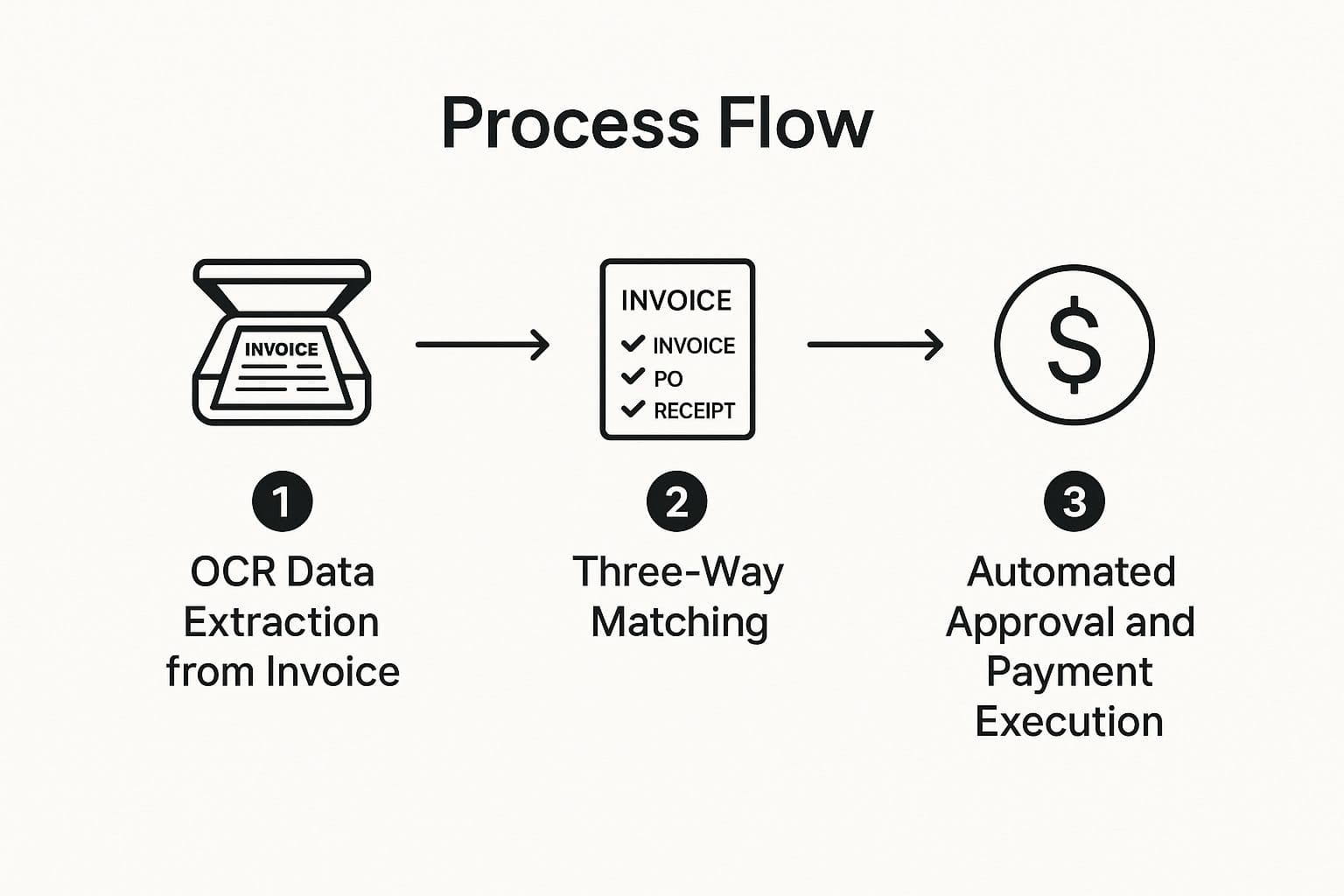Business process automation (BPA) can free teams from repetitive work, speed up operations, and improve accuracy. This article outlines seven practical BPA examples — from invoice processing to financial reconciliation — with real-world results, implementation tips, and recommended platforms you can evaluate for 2025.
June 11, 2025 (6mo ago) — last updated December 6, 2025 (9d ago)
7 Business Process Automation Examples for 2025
Explore 7 business process automation examples to streamline workflows, cut costs, and boost productivity in 2025 with practical tips and platform picks.
← Back to blog
Unlocking Efficiency: 7 Business Process Automation Examples for 2025
Note: Author and published date remain unchanged.
This article presents seven practical business process automation (BPA) examples that can make measurable improvements to efficiency, cost, and employee experience. Each section explains what the automation does, real-world results, when to use it, actionable implementation tips, and popular platforms. Wherever relevant, links to internal Fluidwave resources are suggested to help you plan, implement, and measure success.
Table of contents
- 1. Invoice Processing Automation
- 2. Customer Service Chatbots
- 3. Employee Onboarding Automation
- 4. Email Marketing Automation
- 5. Procurement and Purchase Order Automation
- 6. Lead Generation and Qualification Automation
- 7. Financial Reporting and Reconciliation Automation
- Comparison: Key attributes at a glance
- How to prioritize automation initiatives
- Next steps with Fluidwave
1. Invoice Processing Automation
What it is
Invoice automation uses OCR, AI, and workflow rules to capture invoice data, validate it (three-way match), route approvals, and trigger payments. It removes manual data entry and speeds the procure-to-pay cycle.
Why it matters (real results)
- Siemens reduced invoice processing from 20 days to 5 days.
- Coca-Cola achieved a 95% straight-through processing rate.
- Shell automated ~80% of 1M+ annual invoices.
When to use it
- High invoice volumes
- Long approval or payment cycles
- Frequent data-entry errors
Actionable tips
- Standardize invoice templates with top suppliers to improve OCR accuracy.
- Start with high-volume, low-complexity invoices to build momentum.
- Define exception workflows and SLA targets for approvals.
- Monitor KPIs (cycles times, exceptions, STP rate) and tune rules.
Popular platforms
SAP Ariba, Oracle, Basware, Workday, Coupa.
Suggested internal links
- Link invoice automation results to related finance/process content: Fluidwave: How to prioritize work

2. Customer Service Chatbots
What it is
Chatbots use NLP and ML to answer common questions, route complex issues to agents, and provide 24/7 support across channels.
Why it matters (real results)
- Bank of America's Erica serves millions of users.
- Sephora increased booking rates by 11% via bot-driven suggestions.
- KLM handles thousands of weekly social conversations with automation.
When to use it
- High incoming inquiry volume
- Repetitive FAQ patterns
- Need for fast, scalable service coverage
Actionable tips
- Automate FAQs and common transactions first.
- Provide clear handoff points to humans for sensitive issues.
- Use conversation logs to refine intents and responses.
- Add rich media (images, links) when it helps clarify answers.
Popular platforms
IBM Watson, Microsoft Bot Framework, Dialogflow, Amazon Lex, Salesforce Einstein.
Suggested internal links
- Link to customer-focused articles and tooling: Fluidwave product pages and guides
Video resource
If you prefer video walkthroughs, replace the embedded iframe with an accessible link to the vendor or demo video.
3. Employee Onboarding Automation
What it is
Onboarding automation digitizes forms, automates account provisioning, schedules training, and tracks completion to create a consistent new-hire experience.
Why it matters (real results)
- Microsoft cut onboarding from weeks to days.
- Zappos automated 70% of routine steps.
- IBM improved new-hire satisfaction by ~35%.
When to use it
- Growing headcount or high turnover
- Complex access and compliance needs
Actionable tips
- Map the candidate-to-first-90-days journey before automating.
- Keep human touchpoints for culture and mentorship.
- Involve IT early for provisioning and SSO integration.
- Collect feedback to continually improve the process.
Popular platforms
Workday, BambooHR, ServiceNow, Microsoft Power Platform, Okta.
Suggested internal links
- See onboarding best practices and productivity tips: Fluidwave: How to stay focused at work
4. Email Marketing Automation
What it is
Email automation uses triggers, segmentation, and personalization to send relevant messaging at scale: welcome series, cart abandonment, re-engagement, and lifecycle campaigns.
Why it matters (real results)
- Amazon, Netflix, and Spotify drive engagement through tailored email journeys and recommendations.
When to use it
- Growing subscriber base
- Need to nurture leads or reduce churn
Actionable tips
- Start with core flows: welcome series, abandoned cart, reactivation.
- Segment by behavior and test subject lines and send times.
- Clean lists regularly to maintain deliverability.
- Map customer journeys to match messages to lifecycle stage.
Popular platforms
Mailchimp, HubSpot, Marketo, Pardot, Klaviyo.
Suggested internal links
- For strategy & productivity: Fluidwave: Productivity strategies
5. Procurement and Purchase Order Automation
What it is
Procurement automation handles requisitions, vendor selection, PO generation, approvals, and receipt matching using rules, budgets, and contracts.
Why it matters (real results)
- Unilever automated 80% of POs.
- Johnson & Johnson reduced PO processing costs by ~60%.
- Schneider Electric cut PO cycle time from 7 days to 2 days.
When to use it
- Large PO volumes
- Complex approval chains
- Need for spend visibility and compliance
Actionable tips
- Tackle high-volume, low-value purchases first.
- Implement vendor self-service portals to reduce inquiries.
- Use mobile approvals to accelerate sign-offs.
- Monitor spend patterns to negotiate better contracts.
Popular platforms
SAP Ariba, Oracle Procurement Cloud, Coupa, Jaggaer, GEP SMART.
Suggested internal links
- Link procurement automation to communications strategy: OKZest guide on email automation
6. Lead Generation and Qualification Automation
What it is
This automation captures prospects, scores leads using behavior and firmographics, and routes qualified leads to sellers with context for faster follow-up.
Why it matters (real results)
- HubSpot customers saw up to 75% more leads after automation.
- Salesforce users reported ~30% productivity gains with automated lead routing.
When to use it
- Inconsistent lead follow-up
- Manual prospecting bottlenecks
Actionable tips
- Define your ideal customer profile and scoring rules.
- Use progressive profiling to reduce friction.
- Align sales & marketing on SLA for follow-up times.
- Track quality metrics: conversion rate, SAL-to-opportunity ratio.
Popular platforms
HubSpot, Salesforce Pardot, Marketo, Eloqua, ActiveCampaign.
Suggested internal links
- For prioritization and work intake: Fluidwave: How to prioritize work
7. Financial Reporting and Reconciliation Automation
What it is
Automation in finance uses RPA and AI to handle journal entries, reconciliations, month-end close tasks, and regulatory reporting.
Why it matters (real results)
- Coca-Cola shortened month-end close from six days to two.
- GE automated ~90% of routine accounting tasks.
When to use it
- Long close cycles
- High volume of routine reconciliations
- Repeated reconciliation exceptions
Actionable tips
- Clean and standardize source data before automation.
- Automate high-volume reconciliations first.
- Keep human oversight for judgment-based transactions.
- Build test cases and monitoring dashboards for accuracy.
Popular platforms
BlackLine, SAP S/4HANA Finance, Oracle Cloud ERP, Workday Financial Management, Trintech.
Suggested internal links
- Link financial automation to governance resources and tools available within Fluidwave.
Comparison: Key attributes at a glance
| Automation Type | Complexity | Typical Resource Needs | Expected Outcomes | Best Use Cases |
|---|---|---|---|---|
| Invoice Processing | High | Integration + vendor standardization | Faster processing, fewer errors | Accounts payable-heavy orgs |
| Chatbots | Moderate | Ongoing training, content upkeep | 24/7 support, lower handle time | Customer support, high-volume inquiries |
| Onboarding | Moderate | HR + IT integration | Faster ramp, better compliance | Rapid hiring, global teams |
| Email Marketing | Moderate | Content + analytics | Higher engagement, revenue lift | Demand gen, e-commerce |
| Procurement / PO | High | Change mgmt, vendor onboarding | Spend control, cycle time cut | Centralized purchasing |
| Lead Gen & Qual | Moderate | Data & scoring models | Better lead quality, faster follow-up | B2B sales pipelines |
| Financial Reconciliation | High | Data quality + RPA | Faster close, higher accuracy | Accounting & audit teams |
How to prioritize automation initiatives
- Identify high-volume, repetitive tasks that consume skilled people hours.
- Estimate ROI: time saved, error reduction, and cost avoidance.
- Start small with pilot projects, prove value, then scale.
- Involve stakeholders (finance, IT, HR, sales) early.
- Measure outcomes and iterate.
If you need a simple template for scoring initiatives, consider metrics like potential time savings, implementation complexity, and business impact.
Next steps with Fluidwave
Centralizing your automation efforts in a single platform simplifies monitoring, governance, and optimization. Fluidwave helps unite workflows, connect systems, and measure automation outcomes. Explore these resources to get started:
- Product overview: https://fluidwave.com
- Planning and prioritization: https://fluidwave.com/blog/how-to-prioritize-work
- Productivity & strategy: https://fluidwave.com/blog/productivity-strategies
Ready to test? Start a free trial on Fluidwave to prototype an automation flow and measure results quickly.
Key takeaways
- Automate high-volume, repeatable processes first.
- Optimize the process before you automate it.
- Keep humans in the loop for judgment-based tasks.
- Use data to measure, tune, and scale automation.
Automation is not a one-time project; it is a capability you build. Applied thoughtfully, BPA can deliver faster decisions, lower costs, and a better employee and customer experience.
Focus on What Matters.
Experience lightning-fast task management with AI-powered workflows. Our automation helps busy professionals save 4+ hours weekly.